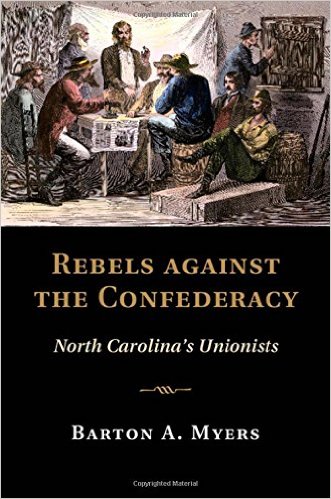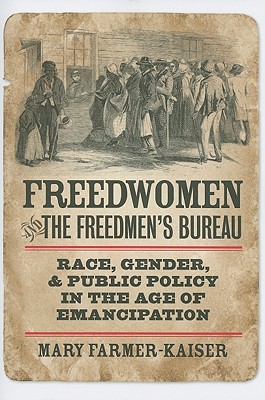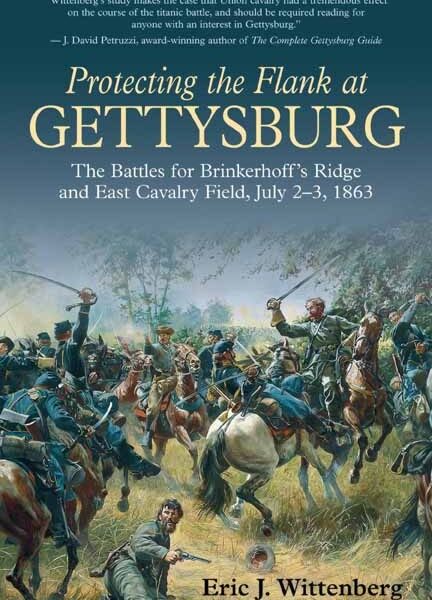Rebels Against the Confederacy: North Carolina’s Unionists by Barton A. Myers. Cambridge University Press, 2014. Cloth, IBSN: 978-1107075245. $90.00.
 Barton Myers’s new study of North Carolina’s unionists during the Civil War and Reconstruction is the latest contribution to a field that has, over the last fifteen years, developed in interesting and rich ways. We know a good bit about the nature of southern dissent—why it happened, where it flourished, what its consequences were—and about the dissenters themselves, men and women who ranged across the spectrum of the South’s population, white and black. Studies of unionism have brought together the many facets of the Civil War (military, social, geographic, and cultural) in ways that illuminate the complex meanings of this event for the South and its people.
Barton Myers’s new study of North Carolina’s unionists during the Civil War and Reconstruction is the latest contribution to a field that has, over the last fifteen years, developed in interesting and rich ways. We know a good bit about the nature of southern dissent—why it happened, where it flourished, what its consequences were—and about the dissenters themselves, men and women who ranged across the spectrum of the South’s population, white and black. Studies of unionism have brought together the many facets of the Civil War (military, social, geographic, and cultural) in ways that illuminate the complex meanings of this event for the South and its people.
Myers’ study is a particularly welcome addition to this field as it is the first statewide treatment of North Carolina’s dissenters, an oddity given that the state was home to one of the few truly organized unionist movements: the Heroes of America, or Red Strings. Like others before him, Myers has made good use of Southern Claims Commission testimony, recorded in the postwar period as loyalists petitioned the federal government for compensation for property lost to the invading Union army. These sources, along with a range of Union and Confederate military records and state papers, allow Myers access to the worldview and experiences of the varied North Carolinians who resisted the Confederacy.
Demographic research in Southern Claims and the 1860 census leads Myers to conclude that North Carolina’s unionists were largely southern-born white men and women of Whiggish political leanings. The heads of these households were generally poor and middling farmers, but also included a substantial proportion of artisans and mechanics, as well as some professionals and planters. Myers resists the tendency, more common in a prior generation of scholarship, to see economic class alone as a causal factor in the creation of unionism. Instead, “Class was as much about social and cultural outlook, shaped by profession and position within one’s community, as it was about economic status rooted in how much money in real or personal property someone owned” (24). Ambivalence about slavery, and occasional outright abolitionism, was a feature of many white unionists’ views, as was pacifism among certain parts of the Quaker communities of the state. Enslaved and free North Carolinians, too, made up key portions of North Carolina’s dissenting population. Myers is careful to note that not all North Carolinian African Americans can be understood as “unionists” prior to the advance of Union troops into the state late in the war—many “hated both the Union and the Confederacy because of slavery,” he contends, and only later became convinced that “the Union represented freedom” (42).
Myers also outlines the ways in which North Carolina’s unionists were occupied—not by Union forces, which maintained sustained wartime presence only in a few coastal counties—but by an expansive, aggressive Confederate state interested in controlling their communities, conscripting their bodies, and punishing dissent. At the same time, however, the nature of this Confederate presence was diffuse, and often highly localized. Dissenters were monitored mostly by neighbors who supported the state—pressure that often produced more dissent over time, rather than less, especially after the advent of conscription in April 1862. Finally, local kinship and social networks played a key role in unionists’ ability to resist the Confederacy. “These networks were often made up of family or neighbors, frequently crossed racial, class, and gender lines, and were absolutely vital to sustaining Unionism in the face of a determined Confederate majority” (81). Probably one of the most famous of these networks was quite formalized: the Heroes of America, estimated as having some 10,000 members in the state. Though the core of those who belonged were unconditional loyalists, as dissent spread into other quarters (due to wartime privation, homefront destabilization, and the constricted political environment), the ranks of the order expanded to include “Confederate conscript evaders, deserters, and disaffected citizens of many stripes” (114). Intriguingly, Myers shows that at least in the central Piedmont, the Heroes were interracial; local chapters initiated multiple African American members alongside whites (116).
Considerable attention is given to the some 10,000 white and black men who enlisted as formal soldiers in white and black Union regiments, and Myers makes good use of the United States Civil War Service records and the 1860 Census to establish the demographic profile of these men and the nature of their wartime service. Most soldiers were poor men, with the poorest hailing not from the mountain counties, as might be assumed, but from the coastal counties that were occupied earliest by the Union (108). This is an interesting finding—one that may bear out other studies that have suggested that, as soldier-aged men were generally younger and less likely to own land of their own, their economic profiles may differ in important ways from that of their fathers and larger households. But Myers also includes in his averages the four regiments of African American men whose personal property—even if they owned some—would not have been recorded in the census because they were enslaved. He does not disaggregate the enslaved soldiers from the free soldiers in this analysis (indeed, it appears that he assumes that all but the free black men are propertyless by definition), raising a question about the extent of the difference in property ownership between the white soldiers from the mountain counties and those from coastal counties.
Myers also adds to our understanding of the guerrilla war in North Carolina. He is particularly attentive to thirty-two counties, scattered across the state among four Congressional districts. All of these districts were Whig strongholds during the antebellum period and “subsequently became some of the most politically divided communities during the war” (124). In most studies of guerrilla warfare, historians have emphasized the role played by a destabilizing Union army; in this scenario, Confederate guerrillas marshal themselves to resist incursions, prompting a range of harsh federal counter-measures, including the fostering of unionist counter-guerrilla efforts. This is certainly at work in North Carolina, too, but Myers argues that the “most widespread form of irregular war in North Carolina was the anti-Confederate people’s war of self-defense and resistance that emerged among disaffected citizens, deserters, conscript evaders, and unconditional Unionists . . .” (125).
In this story, loyalist irregular warfare was offensive, driven less by the opportunity to ally with stronger Union forces who arrive on the scene than by critical masses of local people who could throw up a defense against Confederate authorities seeking to conscript them, impress their goods, or harm their families (126). Myers argues that the level of resistance these citizens provided was utterly destabilizing to the state, making it virtually impossible by early 1865 for North Carolina, or the Confederacy, to govern large swaths of its people. Here, Myers work intersects nicely with Stephanie McCurry’s contention in Confederate Reckoning that the prerogatives of the “disfranchised” of the South—white women and African American men and women—were the great overlooked and underestimated element of the Confederate project. When these disfranchised people asserted their claims on the state and, rebuffed, organized to resist it, they damaged the Confederacy badly. Though Myers cites McCurry, he does not engage her argument directly. This is unfortunate, because much of what he is describing—a largely male, disfranchised population upending the Confederate state because it has failed to protect them—could both amend and support some of her findings.
This is an interesting book that adds to our understanding of unionism in North Carolina. But there are some weaknesses. The question of how the Confederacy defined treason is underdeveloped—Myers says treason was “in the eye of the beholder,” but we would have benefitted from understanding exactly how North Carolina and the Confederacy defined treason, and then how that definition was, or was not, applied (60). This is also important because, as Myers readily acknowledges, “unionists,” per se, represented only a small number of the people who end up resisting the Confederacy. The work frequently refers to locations (the chapter on irregular warfare makes geography a central feature), but Myers does not provide maps, nor do we learn much about the nature of these regions, other than their political affiliations and their rates of slaveholding. The last chapter on Reconstruction, while welcome and illuminating, nonetheless feels rushed in contrast to the detailed treatment of the war years. Most significantly, the monograph is surprisingly narrow historiographically. Myers has the benefit of years of scholarship on this subject throughout the South, but he engages with a fairly limited set of works, and rarely refers to events or patterns having to do with unionists or loyalty outside of North Carolina. This is a missed opportunity. A number of Myers’ findings either bolster or revise the conclusions of other historians (as in the case of McCurry, above), and greater attention to these factors would have allowed readers to draw deeper conclusions about the significance of North Carolina unionists in the history of southern dissent.
Margaret M. Storey is Associate Professor of History at DePaul University and the author of Loyalty and Loss: Alabama’s Unionists in the Civil War and Reconstruction (2004).




